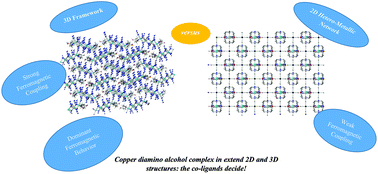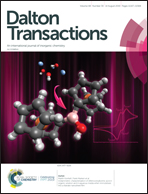Magnetic dimensionality and the crystal structure of two copper(ii) coordination polymers containing Cu6 and Cu2 building units†
Abstract
The electrostatic self-assembly reaction of the [Cu(HL)]2+ cation, where HL = 2-(2-aminoethylamino) ethanol, and the N3− or [Fe(CN)6]4− anion leads to the formation of two coordination polymers with the general formula of [Cu6(μ1,1-N3)6(μ1,3-N3)2(μ1,1,3-N3)2(μ1,1,1,3-N3)2(HL)2]n (1) and {[Cu(HL)]2[Fe(CN)6]·H2O}n (2), respectively. The resulting compounds have been structurally characterized by a single-crystal X-ray diffraction technique. Compound 1 possesses a rare 3D structure. It contains centrosymmetric hexanuclear repeating units, which act as six-connected nodes in the final network and copper(II) ions are joined together by azide anions with four different types of bridging modes, μ1,1, μ1,1,3, μ1,1,1,3, and μ1,3. The structure of compound 2 is a 2D heterometallic CuII/FeII layer in which the [Cu(HL)]2 nodes and the octahedral [Fe(CN)6]4− linkers are joined by μ2- and unusual μ3-CN bridging modes. Detailed static and dynamic magnetic analyses of 1 reveal a dominant ferromagnetic intracluster interaction and a ferromagnetic 3D ordering transition below Tc = 5 K. The variable temperature magnetic susceptibility measurements of compound 2 show a very weak ferromagnetic coupling between the nearest Cu(II) ions. Also, EPR spectroscopy of these compounds has been investigated in the solid state. Nanocrystals of compound 2 have also been synthesized by a sonochemical process under different reaction conditions. The results show that the crystallinity degree and uniform distribution of nanosheets are inversely dependent on the irradiation time.



 Please wait while we load your content...
Please wait while we load your content...